#Eastern Kingdom of Mikado
Explore tagged Tumblr posts
Video
youtube
Rinnosuke's Stage Theme: Curious Old Shanghai Tile
I do hope I got the information for this relic correct henceforth
twas incorrect last entry~~
are these “tags” to leave signs should someone find this ? bookmarks perhaps? i doth believe so~~~ let thine “tagging” be correct this day~~
quite unlike any music that I’ve heard before.... so very rapid in pace~~~
does this rinnosuke fellow study relics as well? I would most certainly like to meet him and discuss my findings should the monastery allow it~~~
i quite fancy his appearance~~~
what of this “shanghai” and “mahjong” do they involve tiles ? the long nights of research continues still it would seem~~~
#youtube#youtube video#music#ZUN#touhou#touhou project#touhou unreal mahjong#curious old shangjai tile#rinnosuke stage theme#rinnosuke morichika#threw some larp in cause why not#i larp as someone finding modern things and them being relics to them#larp#larping#eastern kingdom of mikado#sometimes anyway
2 notes
·
View notes
Text
It's actually weird in this light that Yascony Hill doesn't have a much larger role in SMTIV's shenanigans, but then again leaning too much into the significance of Yasukuni Hill would have been too risky, being a rather divisive subject in Japanese society.



What is Yascony Hill?
Yesterday a new comment on Identity Crisis 3 clued me in to something I'd never heard before about SMT4: The name "Yascony"--and that it's mentioned in a strategy guide. Obviously meant to evoke "Yasukuni", it's where the game begins with the protagonist and Issachar just chilling near its lake. Sure enough, the guide in question that contains it is the mini-guide that was included with the US first edition of the game; I could find no mention of it in the Japanese guide, artbook, or World Analyze tomes, though it's totally possible i overlooked it (check them out on Vesk's archive if you want!). Without corroboration from a Japanese source, it makes the authenticity somewhat hard to gauge, but the name itself is localized in English in the same style as the other areas of Mikado (a deliberately askew romanization as an attempt to match that the familiar Tokyo districts' names are rendered in Katakana in Japanese):
キチジョージ, Kichijōji = Kiccigiorgi
シンジュク, Shinjuku = Shene Duque
....et al. I honestly forget the others. But it should then follow:
Yascony = Yasukuni, ヤスクニ
Since the name follows that pattern, I find it hard to believe it would have been invented by Atlus USA. And, then, why would the American branch name a location after the controversial Yasukuni Shrine? Something is obviously missing here, or I missed a mention of it in JP. It fits the game's Japaneses nationalist themes all too well. Weird.
79 notes
·
View notes
Text
when tumblr dies im going to start posting from the eastern kingdom of mikado
152 notes
·
View notes
Text
An idea I think would be fun is that centuries after the events of SMT4, Blasted and Infernal Tokyo both become evil empires. They idolized their version of King Akira, and took their stated ideologies to the limits with neither nuance nor restraint.
That's not to say that either Akira did a bad job; they did what was necessary at the time to save their people from disaster. It's just that if you took their actions without knowing that context, they would look incredibly evil.
So I think that their kingdoms would become evil empires if their future rulers continued their policies well beyond the states of emergency that spawned them.
Infernal Tokyo
Infernal Akira would seem like a cartoonishly evil overlord if you didn't know where he was coming from. Under his rule, humans are cattle to be eaten and bred, demons run a kind of protection racket, and he calls this equality. He even killed the previous king! And given that he's a coward and a weakling at the top of a society that values strength above all else, he'd seem a massive hypocrite.
Except most of the problems with Infernal Tokyo aren't his fault. Kenji was the one to start the demonoid/neurisher system; the worst you can say about Akira is that he didn't abolish it. And he couldn't. The obviously good step of freeing the neurishers would be disastrous; either the demonoids comply and starve, or they'd rebel openly, which would leave Akira powerless and the neurishers right where they started.
Akira found and enforced the minimum level of cruelty required for his current society to function. To many outsiders, that level is shockingly evil, but he's loved in his time because it's so much lighter than before.
Future generations would idolize King Akira, not unjustly, but it's easy for them to miss the point. He didn't draft a blueprint for some ideal society; he wrote laws and regulations to deal with the current disasters plaguing his city. Let's look at the specific orders he gave, and how future generations can screw them up.
Every district takes a census, and if they need Neurishers, more are sent there. That is how he ended both famine and war; districts fought over and hoarded Neurishers until he distributed them equally. It also sets up precedent for future kings to arbitrarily separate families or rip people from their homes.
Neurishers are mandated to be drank from every other day. In his time, that's a huge load off because they were drained every day, all day. But in the future, there might be so many Neurishers that forcing all of them to work half the time is seen as gluttonous, or maybe there's a future where Neurishers are required to work on top of providing Magnetite ever other day.
Some Neurishers are assigned to breed and make as many babies as possible. It's to ensure the survival of humanity, but even Akira's sorry about it. If the population stabilizes within his lifetime, I can see him easing back on this, but if he doesn't...
This isn't necessarily an order, but Akira's subordinates from Kasumigaseki wound up killing Demonoids who refused to follow him. That can easily turn into death squads killing those suspected to be disloyal.
Blasted Tokyo
Blasted Akira doesn't do anything evil. It wouldn't help his situation. But he does give Flynn and co. a speech about how he's going to use the demons from the Expanse to rebuild the Eastern Kingdom of Mikado; judging by the DLC, he did a good job building cities before the Ancient of Days blasted it back into desert.
Enslaving demons to build your city isn't any more morally objectionable than what your average SMT protagonist gets up to. What might get spicy is if future generations start seeing that anyone who comes through the portal is a 'demon' to be enslaved, even if they're human.
So this hypothetical evil empire would be, well, an empire. It rules over vassal states that are forced to give tribute, regards noncitizens as nonhuman, and the central state contributes nothing of value.
In King Akira's time, there was nothing they could produce. They lived in a desert and burned Pluto corpses for fuel. If they didn't steal, they'd have nothing. By the time the land is arable once more, agriculture might not be as easy or profitable as piracy, so the Eastern Kingdom of Mikado continues as an interdimensional demon summoning pirate state well beyond its need to be one.
On a semirelated note, Blasted Akira only gets a speech about his ideals and how he's going to reform the city, while Infernal Akira gets a whole bunch of NPCs saying what he already did and how. I think it's because we need a lot more assurance that Infernal Akira is doing the right thing, considering both his personality and the whole 'demonoid and neurisher' thing.
King Aquila of Mikado
Now let's reverse it with King Aquila. We know how Mikado turned out after 1500 years after he created the country, and we see his orders, but why did he make them? What context was lost to time?
Let's start with the part of the Samurai Code that forbids them from entering Tokyo, and how Aquila assigned the Minotaur as gatekeeper. From Nanashi's flashbacks, we know Aquila always intended for Mikado to unite with Tokyo, so why stop them?
Look at the plaque in front of the Hall of the Minotaur. It says, "Those who serve God Almighty: Thou shalt not proceed beyond this door." It sounds like Aquila isn't necessarily trying to stop the Samurai, but those who would follow the Monastery's orders. My guess is that he suspected that some fanatics would try to purge Naraku of the Unclean Ones, and the sign is for them.
I've heard a theory that the stark Luxuror/Casualry split was deliberately created to foster dissatisfaction, so that the Casualries would eventually rebel.
I also think that Aquila tried to amp up Mikado's food production to be much greater than their current population, to feed the future Tokyo emigres.
On a semirelated note, for fanfic purposes, I like the idea that Aquila was basically so terrifying that nobody wanted to speak ill of him after his death. He's honored as the ideal king because everyone's scared to write down his less than savory moments.
#shin megami tensei iv#shin megami tensei 4#smt4#smt iv#smtiv#shin megami tensei#smt akira#akira smt#smt 4#smt 4a#smt4a#blasted akira#infernal akira
24 notes
·
View notes
Text





Samurai's of Mikado backgrounds for the Samurai of the Eastern Kingdom of Mikado fans.
Sorry to all my followers who followed for SMT content, I still love the series I'm just not interested in playing Vengance atm
#smt iv#smt iv flynn#smt iv walter#smt iv Johnathan#smt iv isabeau#smt iv samurai#smt#shin megami tensei#kaedehara kazuha
14 notes
·
View notes
Text
Also I’m glad it confirmed what I already knew which was that Jonathan absolutely is constantly haranguing Walter about the Samurai Dress Code

I did fujo tf out btw
8 notes
·
View notes
Text
AU where after shit goes down with the Black Samurai, the young samurai are sent down into the Underworld to retrieve the Once and Future King, who had been hidden away at his birth to prepare him for the day he'd have to save the Eastern Kingdom of Mikado.
OK tbh this AU was mostly thinking how funny it'd be if someone came down the Sky Tower and handed baby Nanashi over to Fujiwara and Skins. "This is the reincarnation of the first king of Mikado, who I'm told was a friend of yours. We need you to raise him. No, we can't do it in Mikado, prophecy says we need him hundreds of years in our future. We'll come back for him eventually. Yes, this was in his will."
9 notes
·
View notes
Text



if you say eastern kingdom of mikado one more time I swear to god
#smtiv#smt iv#walter smtiv#isabeau smtiv#jonathan smtiv#flynn smtiv#sara draws tag#fanart#I’m having a moment.
215 notes
·
View notes
Note
Oh goodness me! What is she doing in the Eastern Kingdom of Mikado in Shin Megami Tensei IV?

Mirabelle is in the Eastern Kingdom of Mikado from Shin Megami Tensei IV! Looking for Isabeau, I assume.
16 notes
·
View notes
Text
Spot the lie: Shin Megami Tensei edition
Note: I'm including everything under the SMT label in English except the Persona games. No I don't care if they're technically part of another subseries in Japan. Also, these apply to the original releases. I know some have been updated but I haven't played them.
I especially want to hear from people who haven't played them because this feels too easy for a veteran.
Poll results are in and I'm very disappointed that only 3.7% of you got it right.
I will now reveal the correct answers:
1. TRUE - The first major boss in Devil Survivor, Beldr, can only be killed by mistletoe, a mistletoe-shaped cellphone strap is just as effective.
2. TRUE - Yggdrasil is sapient and steals time warping powers from the Disir. The protagonist has to go back in time to save themselves with the help of the Norns (who have evolved from the Disir who gave him the quest, you know like Pokemon)
3. TRUE - Dante made a guest appearance in the original release of SMT Nocturne. Later versions replaced him with Raidou Kuzunoha, the protagonist of two games in the Devil Summoner spinoff series
4. TRUE - It's ordinary literature, there's nothing wrong with it the citizens of the Eastern Kingdom of Mikado are just that brainwashed
5. TRUE - The entry is in Strange Journey. "Originally, he looked like an abominable snowman, but perhaps he changed form to more efficiently freeze people."
6. TRUE - The bondage angel design debuted in SMT 2. Here's a screenshot of SMT 1 showing its original design.

7. TRUE - A lot of people voted for this one but it's actually true. Cerberus' single head is a reference to the original novel the series is based on (Digital Devil Story). He is depicted with three heads in SMT: IMAGINE, Soul Hackers, and Digital Devil Saga.
8. TRUE - I did not know the origin of David's name myself so I looked it up. His design is possibly a reference to the poem Danse Macabre by Camille Saint-Saens.
9. FALSE (ish) - It's actually the reverse: Astaroth wishes to become the goddess Ishtar (technically to return to being Ishtar but in game terms Ishtar is treated as his "evolution"). He is usually required in order to fuse her. In some games, the two don't appear to be connected at all.
10. TRUE - As the accuser, Satan is part of the Law alignment (and therefore on YHVH's side) against Lucifer, who (usually) represents the Chaos alignment. His role in SMT IV Apocalypse is more complicated.
Anyways good job everyone. Everyone gets a cookie.
18 notes
·
View notes
Text

Gaston Character Page Translation
Translator: VerdantGrove
ENG Proof/Typesetting: Elegy
Reposting is discouraged, but if you choose to do so, please keep the watermark in the image.
—
Gaston Introduction
A samurai from the Eastern Kingdom of Mikado, he is the junior of Flynn and his friends. He is the true younger brother of Navarre, evidenced by his excessive pride, but he holds something of a grudge against his older brother for dirtying family name. Although he has come to accompany Nanashi and the others, he cannot see his brother's astral body, so he often criticizes his brother before his very eyes.
Commentary by Masayuki Doi
When I first heard that Navarre's younger brother would actually make an appearance, I laughed… No, I meant to say that I was surprised. The hairstyle and facial expression associated with that family were a no-brainer (laughs). As he's one of the (newly) established samurai elite, we made him wear more period-advanced clothing, like those of medieval musketeers, over his samurai uniform undergarments. The mark of the Cross represents God and the four archangels. The Spear of Michael was the item that originally felled Lucifer, so we laid out some of the same design motifs that we used for Lucifer.
46 notes
·
View notes
Text
deleted the sleep schedule complaining cause I've been complaining about it too much~~ based on the way things work with me tho I'll work my way back around eventually~~
sorry for complaining about it so much~~
thought of deleting the magnetite question post but that was for a bit of fun thinking and (hopefully) didn't show incompetence with a series I hold so dear~~
or the before bed (what do these skills do) post where I rant and looked them up anyway.... i deeply worry about coming off as stupid
I now worry I've ether revealed too much information or have made myself seem incompetent to some degree~~
now anxiety is gnawing at me trying to complete a stupid cycle I'm trapped in~~~ I'd often delete my blog cause I feel like I've revealed too much personal stuff~~ but I always come back after a while anyway, different username, same walpaper, theme, and icon... so realistically there's no point in nuking it~~~
I wonder if there are people at the monastery that get too distracted studying relics that they also lose track of time and do what i do? and are constantly backwards sleep schedule wise as a result?
of course anyone of any alignment could probably get their sleeping patterns weird; and to be honest it's probably tied more to morality than anything else tho..... begs the question, which alignment would be more likely to constantly flip flop their sleeping schedule?
I'm assuming the day/night cycle is normal in smt iv? in mikado at least perhaps.... Does Mikado have seasons? I'd like to see winter~~~ Lake Mikado frozen over~~~ snow and ice everywhere~~
if you hide in a pile of snow to scare someone what's the likelihood that you'll die? fun isn't worth death methinks~~
Would the samurai uniforms change for winter in that case? Or is it just one standard all purpose one?
I bet I’m so short that if I wore a coat, it would drag the ground… unless they’re fitted per person. Kinda doubt it tho. Cause it seems they get the outfits immediately after the gauntlet rite…
Now imagining that the town would be decked out for whatever holidays they celebrate in Mikado~~ but what holidays would that be? Christian ones? Do we ever get any info on things such as this?
Interesting ~~~
From an anxious rant; into ‘that would be neat if we got more elaboration on this’
Idk how my mind works am sorry~~~ least I’m not anxious in this moment anymore ~~ lol.
Samurai training in the middle of a blizzard? If they train in places on the surface and it’s not just excursion into naraku…
I’ve somehow fused the anxiety with ‘this’ll be neat’ and am not anxious anymore what happened here?
Idk what this post is am sorry, lol. Stuff lately has just been ‘stream of consciousness with updates’
#personal#thoughts#thinking#i think too much#sleep pattern posts deleted#anxiété#anxitey#anxienty#anxi4ty#anxeity#anxiety the fun ruiner#don't wanna delete my blog again#idk how that started to begin with#worry I'll reveal too much info#or just come off as stupid#don't like coming off as stupid#cause I myself am not stupid#rant post that turned into me curious about Mikado#do we ever get holidays for The Eastern Kingdom?#Eastern Kingdom of Mikado#mikado#holidays#from anxiety to that would be neat#or do the angels not like fun#hope you all enjoy my stream of conciousness posts lately#tho I’m assuming no cause I still feel I post too much lately#and I haven’t been larping either cause idk where what little story I’ve got going on is going#gotta make more larp soon tbh~~#it was kinda fun#idk what this post is am sorry lol
0 notes
Text
Let us see the terror of heaven
I was thinking a while ago today about the way angels are consistently designed in Shin Megami Tensei vs the way the Law alignment is sort of steadily portrayed in later games. It's a weird trip but hopefully where I'm going will become clear.
Most of Shin Megami Tensei's angels actually hue fairly close to the "traditional" image of angels, as fair-looking winged humans. We see this for instance in Shin Megami Tensei's Angel.
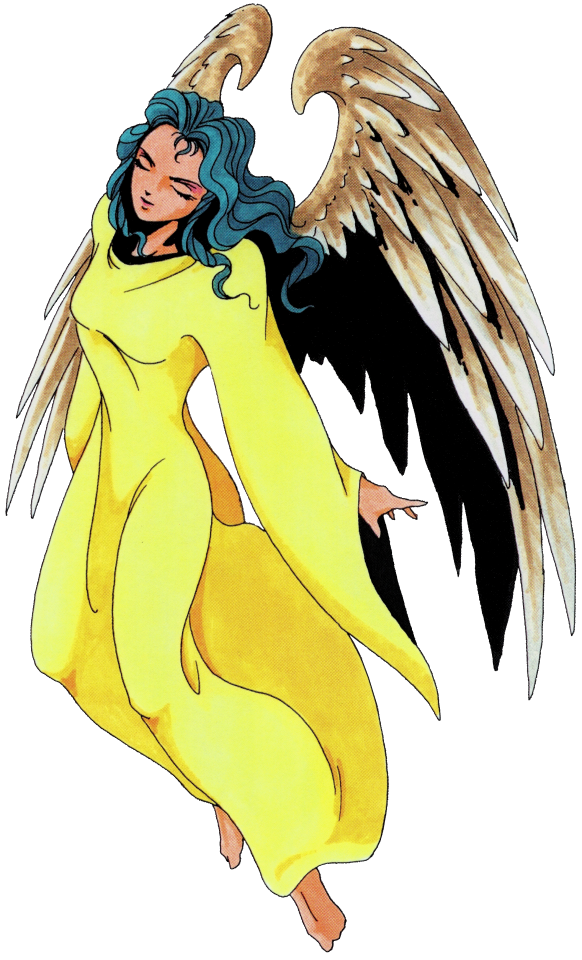
In nearly all of the angels in the Tenshi clan:
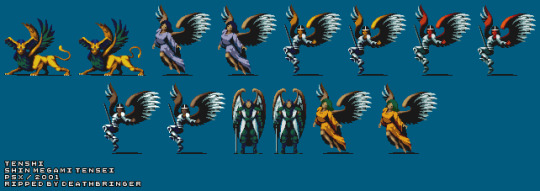
And of course, the Four Archangels/Seraphs/Heralds. Let's just use Uriel as an example here:
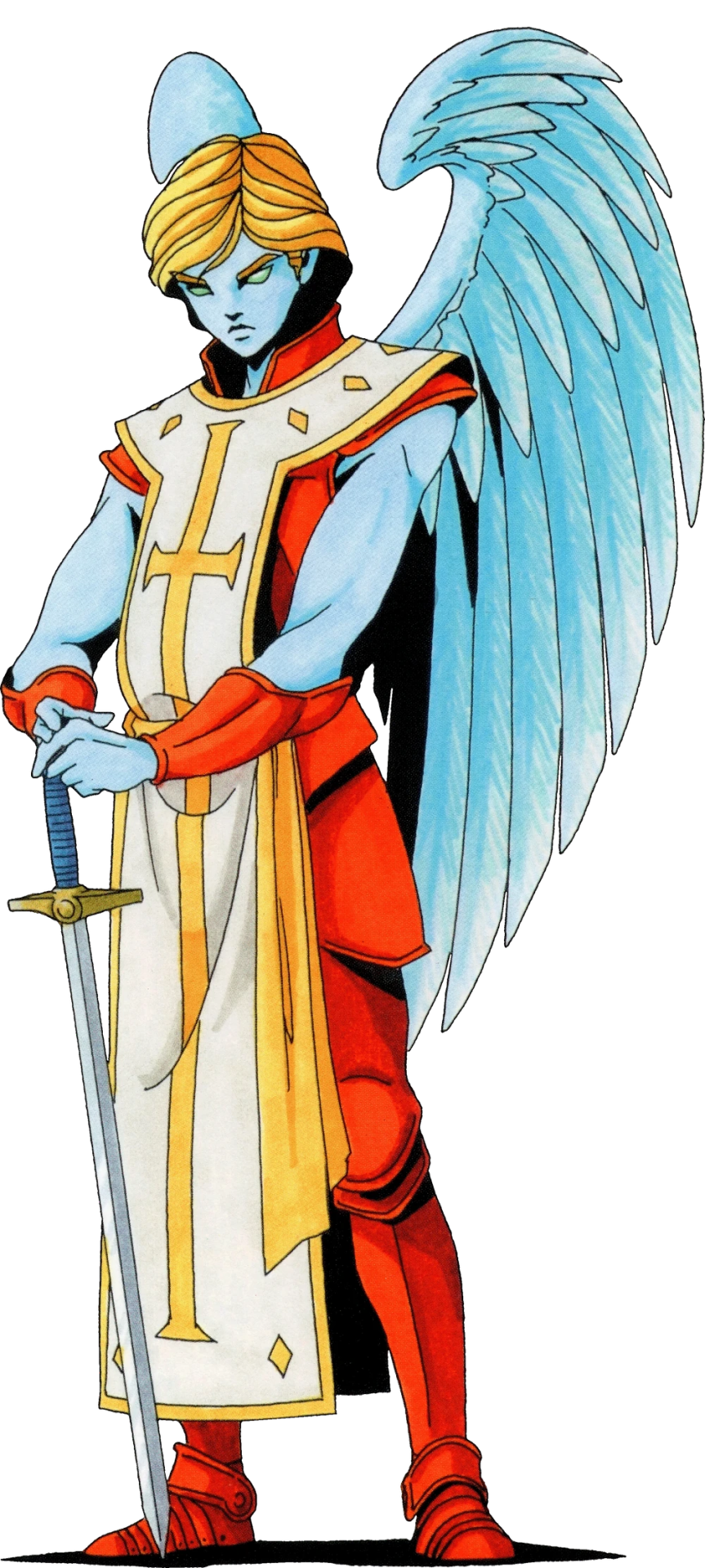
There's also Haniel and Kazfiel whose designs both follow traditional Christian depictions of seraphs. We'll bring up Haniel's art here:
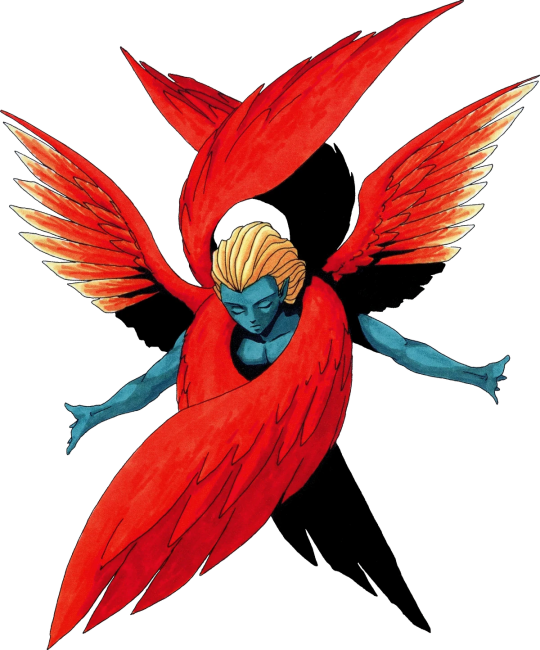
But then we get to Shin Megami Tensei II where we really start to see the "Biblically accurate angels" trope emerge in earnest, where we see the more human/Hellenistic-looking angels alongside some pretty eldritch entities in the Daitenshi clan. For example, Tzaphkiel:
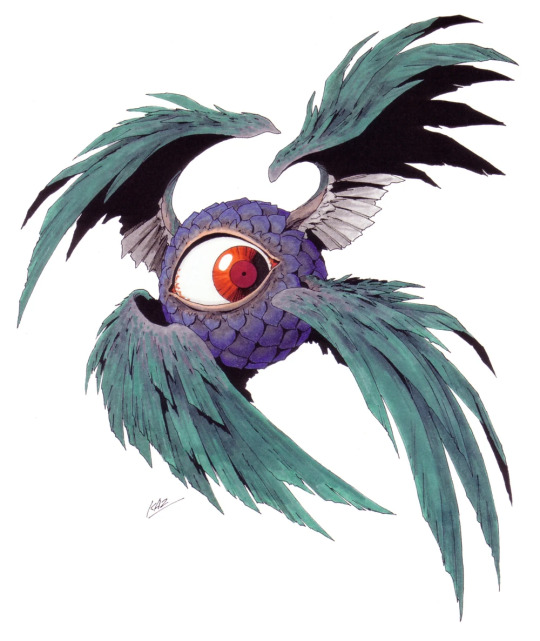
Or how about Ophanim, which seems to be based around Ezekiel's vision of the cherubim:

And then of course there's SMT 2's Satan:
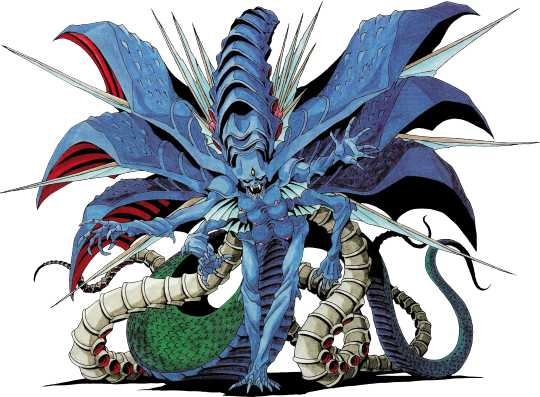
Devil Summoner and Soul Hackers can be seen as developing the inhuman aesthetic of SMT's angels as extending from the "Biblically accurate angel" trope. Let's start with the Tenshi clan in Devil Summoner:

And some of the Daitenshi:

Then Soul Hacker's Tenshi:

And Daitenshi:

With Shin Megami Tensei IV it seems that one of the guest artists, Keita Amemiya, took the inhuman direction for angel design to the nth degree in terms of his approach to demon design in general as reflecting the idea of angels and demons as artificial beings.

At this point I should get to where I'm going here. For a while, at least a decade ago, I might have favoured the idea of the angels as strictly inhuman, or even artifical, possibly to convey the externality and alienness of the repression of the order of God. Keita Amemiya seemed to really lean on that idea, though the designs were certainly rather poorly executed at least for the Four Heralds. But thinking about it, I think the older designs for the Four Seraphs appeal to me for more than just being the classic designs from SMT 1 and 2.
Even though the "Biblically accurate" design direction is very suitably weird both for SMT's context and the linking of the strange and alien to representation of dreadful aspects of divine awe, I find that the more humanlike representation of angels in the context of the Law alignment works better for what, in my mind, I prefer to see. To understand where I'm going, let's look at SMT IV and Apocalypse. Here, the Law alignment is much as it is in SMT I and II, in that it can understood in terms of a single-minded devotion to the order of God, and to the extent that the forces of Law are ruthless in their actions, willing even to wipe out all of Tokyo in order to preserve the Eastern Kingdom of Mikado. In Apocalypse, you see YHVH's "true form" as a monstrous chimera the likes of which, as I remember Eirikr noting, you would probably see as the formulaic final boss of literally any JRPG.
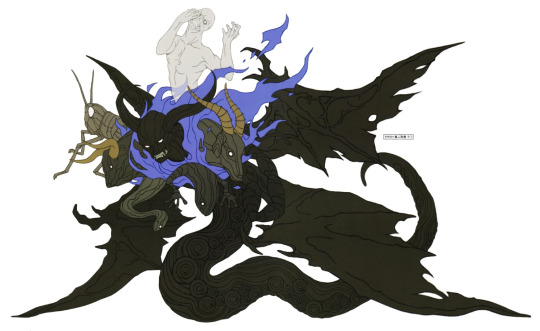
To my mind, it serves to very obviously signify YHVH as unambiguously evil, which, oddly for SMT, is represented as similarly unambiguously demonic. Of course it might be argued that the conceits of Sethian "Gnosticism" are also in play. I think that the opposite approach would be better. SMT IV's approach seems to tie the order of God and the atrocity that the forces of Law undertake to uphold as, all along, the manifestation of a demonic will. But the better idea for me is that all of the same atrocity is done not by monsters but by the traditional figures of light.
Every scheme to dominate the universe, and every massacre that follows to support it, every terror that befalls mankind for its perceived failure, I prefer that we see all of it under the auspice of the traditional figures of light. That would be a far more fitting adage of the inversion that SMT is known for. As Valerio Mattioli said of Rome as portrayed by Luchino Visconti, hell lies in the celestial vaults. And what better way to illustrate that then all of the violence and terror of Law being the instrument not of monstrous chimeras but of celestial form. Of a "beauty" that hides unfathomable violence within itself. And I don't want SMT to be the only place where you can find this idea. Oh no no no I think more media should play with that idea, more art should go all in on this kind of aesthetic-moral inversion.
Update: it occurred to me that I've forgotten something. I forgot to talk about SMT V.
When it comes to SMTV, we see echoes of SMTIV Apocalypse's handling of Law and the violence of order, in that it both reasserts its treatment of that as the affect of an actually demonic will and presents Abdiel's desire to reassert God's order as a plunge to towards the demonic. Hence you see the angel Abdiel transform from sort of an angelic Princess Padme in gold armour into an actual fallen angel, who even gets reclassed as the only Law-aligned member of the Fallen clan.
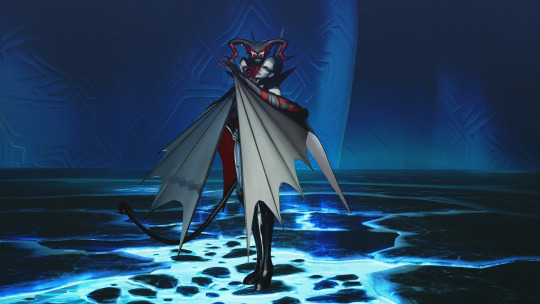
Not to mention her attempt to become a Nahobino resulting in a transformation into a giant demon centaur whose design seems to recall Sirene's fusion with Kaim in Devilman.
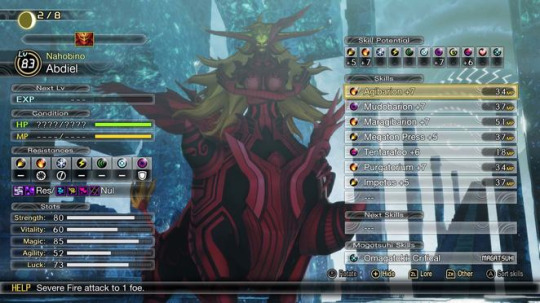
Of course, in context this is all supposed to emerge from the premise of God's death, Abdiel's denial of that death, and the resulting desperation to restore order. But, again, that desire as strictly the affect of the classically demonic to me misses the point. Yet, given the obvious resonances with Nocturne, where three of the main characters merge with their demonic sponsors, it's worth pointing to an obvious contrast: Baal Avatar.
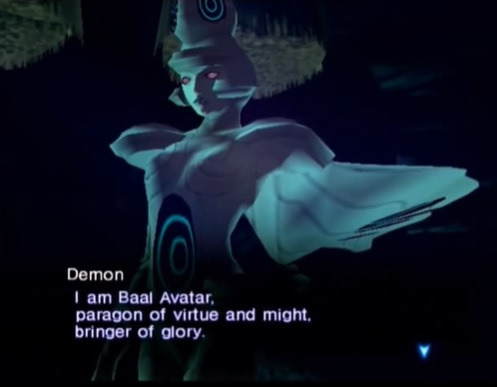
And moreso, the fact that before you see Baal Avatar you witness Chiaki slaughter the Manikins, ramble about how the strong deserve to crush the weak, and then in a flash of light three out of the four archangels (namely Raphael, Gabriel, and Uriel) appear as her allies, which you fight.
youtube
Now there's a setting where the representatives of Social Darwinist violence and atrocity also make no bones about what guides them: the idea that they're making the world beautiful and promoting the ultimate good. Their radiant appearance is not to be understood as a deception covering up some inner demonic nature or demonomania but instead only reflects their seemingly divine conceit. It's not only that they believe they are paragons of virtue. Everything they do, they do as figures of light. And you, a monster among monsters, a cursed being in the world of demons, might oppose them and might just stop them if you choose to. It's really hard to think of anything else that has that angle. It's also somewhat concerning to think that future games might miss the mark.
The development exemplified by Abdiel's transformation into literally a fallen angel ultimately lends not only to certain ideas about the hope that there might be something "unambiguously good" about Law, but also the idea that all the bad things about it are all about concert with the demonic, which is ultimately familiar to the conceit that all of the negative aspects of Christianity are simply the manifestations of a falsification of Christianity, that the "real" blasphemers, heretics, and demons are actually just Christian fundamentalists. But I'm not interested in that idea. I'm interested in the worst that humanity has to offer being contained in its loftiest aspirations of order and in turn represented in the figures of light, because I'm interested in the idea that it is in the name of "the Good" that atrocity always manifests, and for which we cast it into a shadow of the human, in evil.
What we are striving to forget is that the worst deeds in the world are always either utterly human or surely the work of God. Nothing demonic could come close. So let us see more inversion that reflects that insight. The insight that, so far, SMT is among the few media to portray, let alone portray as brilliantly as it often has.
#shin megami tensei#angels#law alignment#michael#gabriel#raphael#uriel#haniel#kazfiel#satan#merkabah#tenshi#daitenshi#seraph#Youtube#shin megami tensei ii#shin megami tensei iii: nocturne#shin megami tensei iv#shin megami tensei iv: apocalypse#shin megami tensei: devil summoner#devil summoner: soul hackers#shin megami tensei v#abdiel
30 notes
·
View notes
Text
I love the passage of ethics esp the last question about if you would stay by a loved ones side forever if they were in a coma and would never wake up because like yessssss of course Jonathan says yes the guy is absolutely married to his completely unjust society that’s currently falling apart at the seams. Me and the rotting corpse of the eastern kingdom of mikado 😋 ✌️
18 notes
·
View notes
Text
i want to drop shirou emiya in the eastern kingdom of mikado and study him under a microscope. see how he copes in there
16 notes
·
View notes
Text
Shin Megami Tensei IV Apocalypse: A Strange Journey
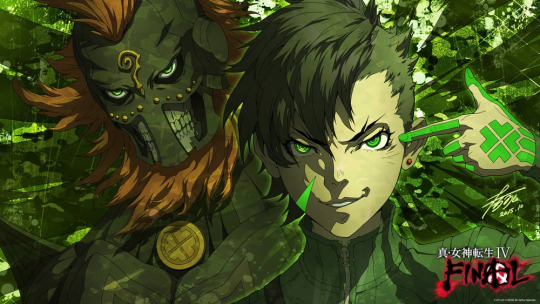
Shin Megami Tensei IV Apocalypse (known as SMTIV Final in Japan) is a sequel to the original SMTIV, both of which are 3DS games. It follows an alternate story that begins near the end of the original, where a new protagonist accidentally kicks off a sequence of events that leads to the game playing out completely differently.
It's... not perfect. The gameplay and audiovisual design are not only top-notch for the series, but for RPGs of the time as a whole, but the story fails to execute on its admittedly interesting ideas, and the third act in particular might be the most spectacular way I've ever seen a piece of media completely fumble the bag. This post will be a chronicle/unstructured rant of my entire two-week journey through the game. Spoilers for both SMTIV and Apocalypse will be covered in detail. Strap in: this is going to be a long one.
For those who aren't aware, Shin Megami Tensei is an RPG series that dates all the way back to the 80s. The gameplay involves fighting demons based on mythological gods and beasts, convincing them to join your party, and fusing them together to create stronger demons. Most SMT games take place in a post-apocalyptic version of Tokyo and center around the conflict between those aligned with the ideals of Law and Chaos. The series is best known for its largest spinoff series, Persona, but SMT has so many other increasingly obscure entries and spinoffs that they could probably form an iceberg video with their titles alone.
SMTIV in particular takes place in the year 2038, 25 years after nuclear war ravaged the world. Thanks to a confluence of factors, Tokyo was protected from the war by a giant dome that covered the entire city. A few survivors managed to breach the ceiling and form a new city up there, and since time flows much faster above the dome, an unusual medieval society called the Eastern Kingdom of Mikado, with "Samurais" and a caste system, has had over 1500 relative years to develop by the time the game starts. The cast of SMTIV hails from Mikado, while Apocalypse starts in Tokyo.
Back to the game. I knew a few things about it before I decided to start playing it, the first (and most striking) of which being the protagonist's design:
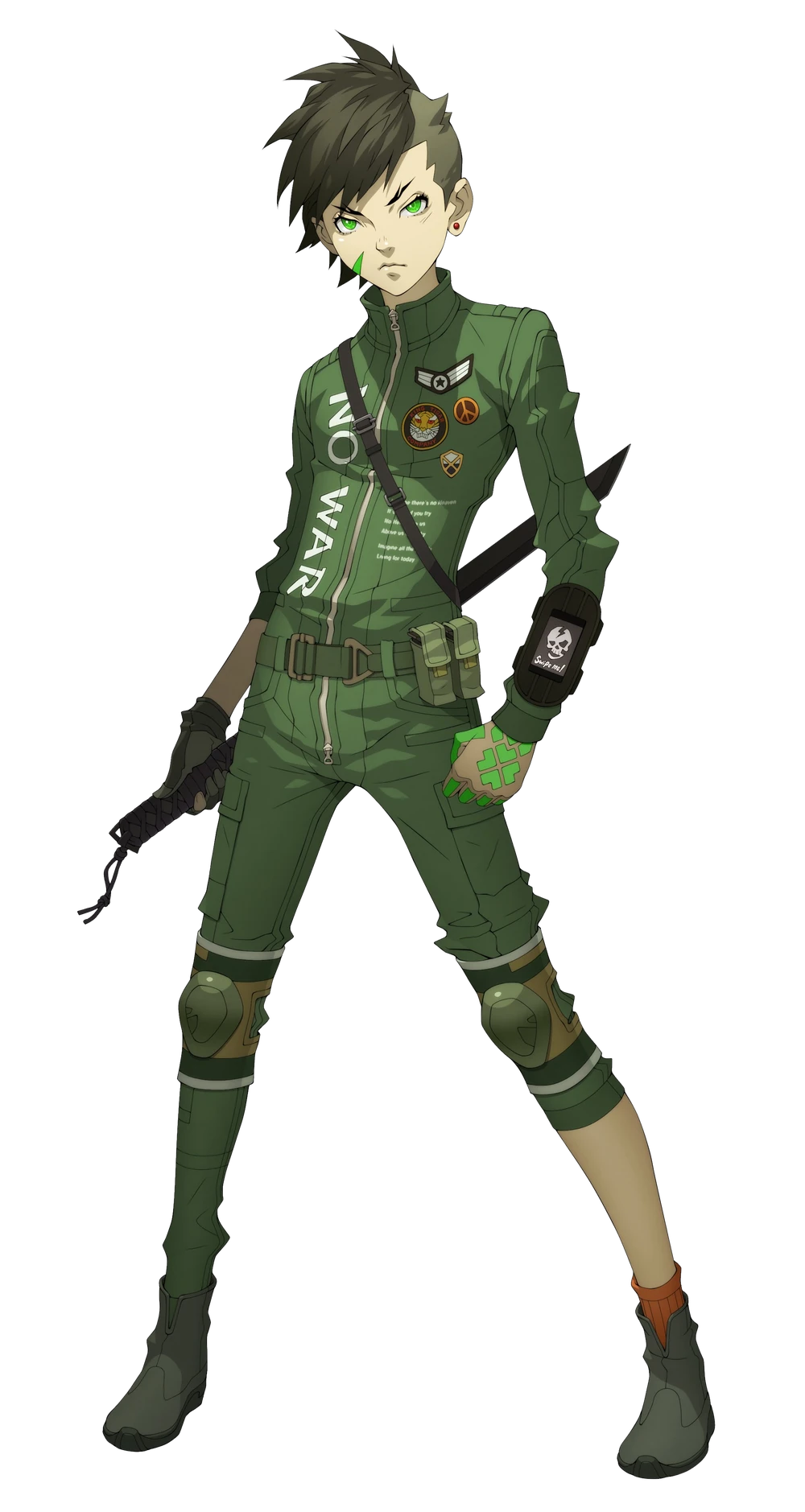
There's just so much to take in here. His haircut is insane, he's got one pant leg rolled up for seemingly no reason, and the "NO WAR" text on his suit and the peace symbol pin are a good indication of how subtle the game's themes will be. My favorite part, though, are the lyrics to John Lennon's Imagine emblazoned right below the pins. They might be too small to make out here, but trust me, they're there. Also, his name is Nanashi, which literally means "nameless."
After an entire hour of downloading a ROM onto my very real 3DS (accompanied by this completely insane blurb) and trying to figure out how to make the DLC CIA file work, I finally opened the game and was immediately greeted by this:
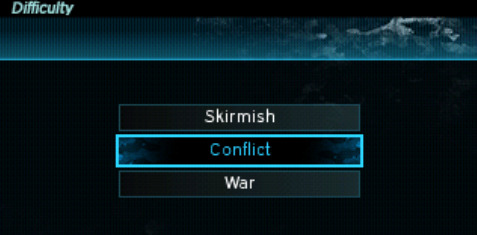
This shit is SERIOUS. We're going to WAR here.
The game opens with two random guys telling Nanashi (who I gave the hunter codename KILLJOHN, as a reference to my everlasting mission to kill John Lennon) and his childhood friend Asahi that they're too young and inexperienced to join the Hunter Association and become official demon hunters, then tasking them to beat up a couple demons as basic combat practice. Nanashi picks a phone up off the floor, starts killing, some demons, and immediately gets jumped and dies. In the afterlife, a demon called Dagda shows up and brings Nanashi back to life under a contract of complete subservience, then jumps into his phone to help him take down the demons.
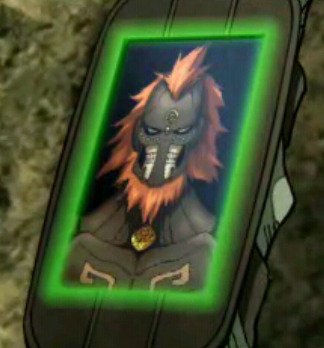
With the two random guys dead and nothing else to do, Nanashi and Asahi collect some demons of their own and start doing quests from the Association. One of these almost gets the two killed, but Flynn, the protagonist from the first game, and his friend Isabeau show up to rescue them. Flynn has a major speaking role in this game, which is always cool to see in a sequel.
Throughout the game, you'll be given several dialogue choices that alter Nanashi's alignment. In vanilla SMTIV, these were centered around Law and Chaos and were entirely responsible for which ending you got, but in Apocalypse, they're more focused around being "good" or "evil" and the consequences for which one you choose are a bit different. Since Dagda constantly (and I mean constantly) tells Nanashi to betray his friends and work alone, and most of the "evil" options are Nanashi acting like a total dick to whoever he's talking to, it reminds me a lot of specifically the SnapCube fandub of Shadow the Hedgehog, where The Devil from The Bible repeatedly shows up and tells Shadow to be an asshole and collect Sin Points.
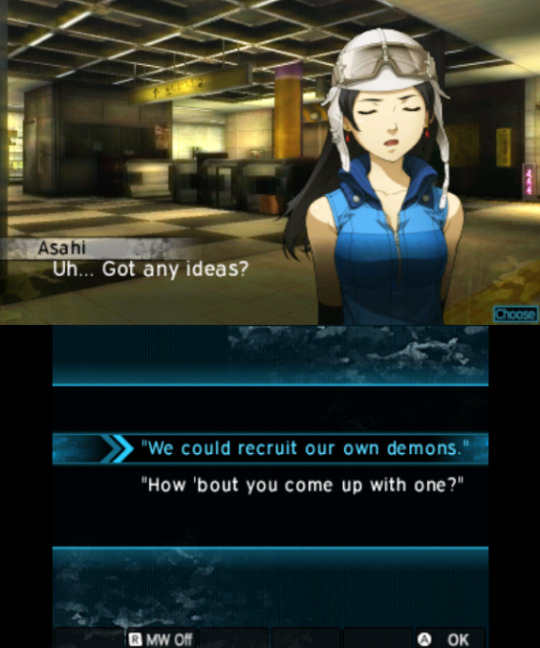
Another fun element of this game is the lore compendium, which contains such things as the entire plot of the first game, an unnecessarily lengthy entry about the preparation and history of fried chicken, and the unrequested information that Isabeau reads yaoi. The fried chicken thing is even lampshaded in-game, just to give an indication of how unserious the game is going to be.
For the gang's next mission, they take a request called "plz stop fight" and travel to the Fairy Forest. Waiting for them is Nozomi, a character from a series of side quests from the first game that's been upgraded to a party member here. Since most of her development already happened in that game, her role in this one is as more of a mentor figure and as a mouthpiece for Dagda's mom, who lent her power to Nozomi so she could carry out her duties as queen of the fairies. She asks Nanashi to take care of King Frost, the king of all Jack Frosts, while unleashing this humdinger of a line:

Your next mission is given to you by some demon guy, who instructs you to go to a really cool waterfall dungeon to unseal a powerful being. With nothing else to do, the gang goes off to do exactly that, and they're greeted by this twink:
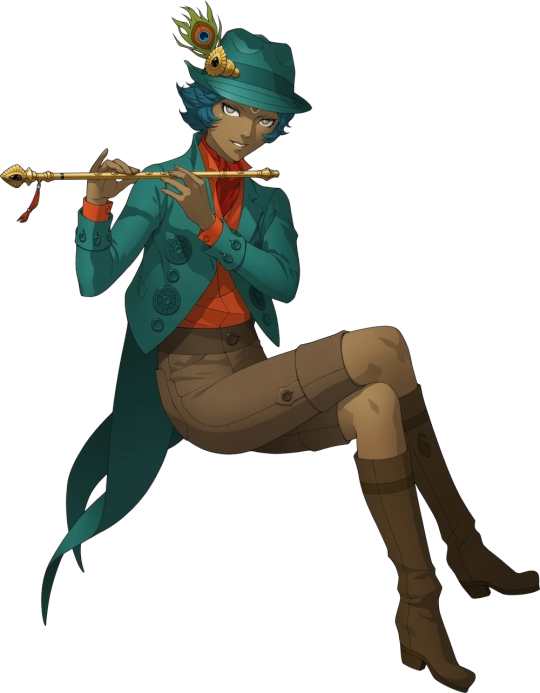
He introduces himself as Krishna, leader of the Divine Powers, a group that wants to create a new universe outside of God's grasp so humanity can be free from his constraints. Unfortunately, this means killing everyone in the current universe, so he's gotta be stopped. He starts a war between the Divine Powers, Merkabah (God's chariot) and Lucifer (Lucifer), kidnaps Flynn to use in much the same way as Dagda has with Nanashi, and fucks off to do his own thing. At this point, Dagda drops one of my favorite lines in any video game:
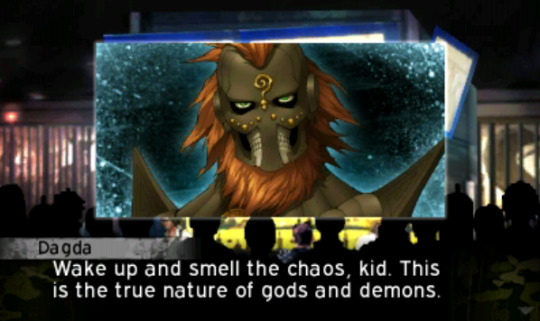
I refuse to believe someone at Atlus wrote this line and unironically thought they were cooking. They are not beating the Shadow the Hedgehog allegations.
The game then gives you two quests and lets you choose which one to do first: clean up the Divine Powers' invasion of the Fairy Forest from earlier, or go to the big tower that leads to Mikado to collect a part for a thing I'll mention in a moment. Both of these lead to boss fights, and I killed both of them in about three turns. SMT has a reputation for being really hard, but if you have enough experience with the series and spend more time nose deep in the fusion calculator than playing the game, it's not too hard to turn any boss in your way into red mist, especially since the first one of the two has a habit of using a skill that guarantees that his next hit will be a critical hit when he already has a status that does the exact same thing.
The second boss of the two is worth talking about a bit more, though. Medusa is a boss returning from the first game, and her encounter here is meant to mirror the one from that game as closely as possible, from the legendarily kickass boss music to the dialogue being nearly the exact same. One line in particular sticks out:
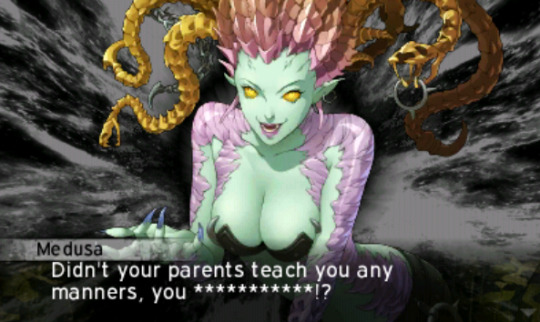
This game has uncensored swears in it, which makes me believe that Medusa just called Nanashi several slurs. You also get a new party member here, but he sucks so I don't feel like talking about him.
This seems like as good a time as any to mention how amazing this game's OST is. SMTIV already had some awesome tunes, and this game naturally carries most of the tracks from there while also adding some unique ones. The entire soundtrack is gold, but some of my personal favorites are the Large Map theme and the Divine Powers battle theme. I'd highly recommend looking these up to accompany your reading if you've already made it this far.
Your next mission is to defeat the Divine Powers' Evil Snake. Joining you is this wonderful gentleman:
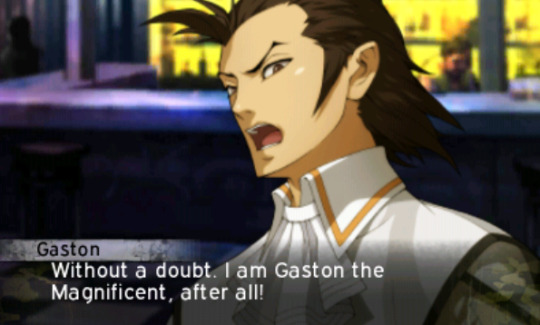
This guy goes out of his way to use your turns to attack. This has a high chance of getting you killed in random encounters. He's also almost necessary to kill Evil Snake, since he carries around a spear blessed by God that's super effective against it. I love this guy. The battle against Evil Snake is also pretty interesting; you need to choose the right dialogue options so you don't get wiped. Most major bosses in both SMTIV and Apocalypse do this, but the Evil Snake fights really make you feel like a tactical smart guy for choosing the right options...
...or at least they would if I didn't have a guide at the ready. If there's one thing I regret about this game, it's looking things up on the wiki way too often and ruining some things for myself that I would've liked to see with my own eyes. I needed the alignment guide to make sure my Sin Points were at sufficient levles and a walkthrough to get through the incredibly crankass final dungeon, but I could have survived without the constant wiki diving.
Anyway, after killing the Evil Snake, a couple of creepy old ladies tell you to kill Flynn and the Divine Powers. The gang obviously objects to the former, so they let you skip that part as long as you let "this weird child" (their words, not mine) named Toki follow you along for the ride.

The second she joined my party, she instantly killed an enemy I ran into and then said this. You can't make this shit up. Isabeau also formally joins the party around this point, rounding out a complete set.
The whole squad goes off to fight the Divine Powers, which completely backfires in their face and ends up revealing to the entire party that Nanashi is essentially a corpse being puppeted along at the whims of Dagda. Nobody is happy about this. After the confronration, one of the Divine Powers sets up a barrier that makes everyone in Tokyo unable to summon demons (except Nanashi because he's different). One of the leaders of the Hunter's Association asks you to quell an invasion of Nanashi's home, leading to one of my favorite dialogue choices in the game:
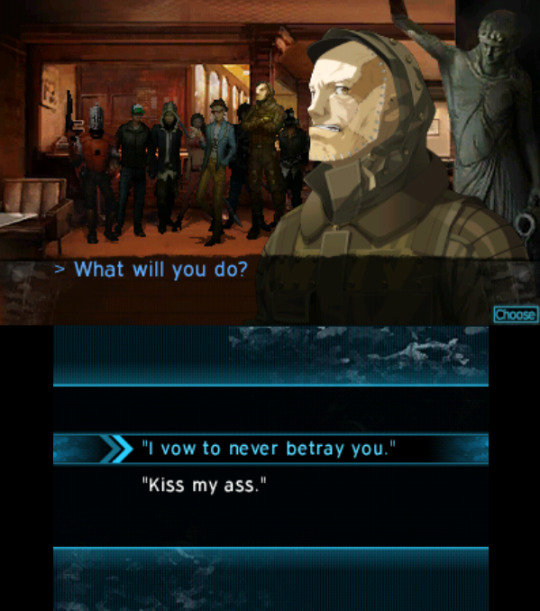
During the invasion, Asahi's dad dies. Womp womp.
While Asahi mourns, the rest of the gang turns their focus to destroying the barrier. To do this, they need to seal five jars that power the barrier through collecting emotions from five of the seven deadly sins, because I guess the Divine Powers couldn't afford all seven. Toki volunteers to do this because she's trained to seal her emotions away, and she gets brain blasted by all five of the sins while she's sealing the jars. After getting through the lust one, she says "I'm too young for this"... and then slightly later, she returns with her mask off and with a habit of calling Nanashi "Master" and openly thirsting over him. This could be generously described as an unorthodox writing decision. Since Asahi starts developing an interest in Nanashi around the same time, this is (to my knowledge) the only SMT game with a genuine love triangle.
On that topic, this seems like a good time to mention a major criticism with the game, that being that it feels more like a cheesy sitcom than a "real SMT game." This is definitely true, but I don't think it's that big of a deal. As I said before, there are like 40 SMT games, so it shouldn't really matter if one of them isn't super dismal and depressing like the rest, especially if the game uses that tone to tell a compelling story. It... doesn't, but that's besides the point. Also, something really funny happened in that dungeon:

Next up: beat up the Divine Powers, for real this time. After getting through a genre staple Fuckass Teleport Maze, you finally get to partake in a formal bout with Krishna, who's probably the hardest boss so far. He loves to stack multiple status effects on your party at once, making it nearly impossible to move at times, while simultaneously tanking your stats and raising his own. If there weren't a party member that blocked status effects, I genuinely don't know how I would have gotten past him. He doesn't even die, either; after you beat him, he just goes "ohhh nooo I've been defeateddd how could this possibly happennnnnn" and fucks off to do some more plotting. Somehow, the entire party is fooled by this expert subterfuge. Flynn is also rescued during this operation, but he's acting a bit freaky.
The next thing you do is infiltrating Mikado for a reason I literally forgot. Since Mikado's Samurai get assigned at the age of 18 and most of the gang distinctly does not look that old, they put on stupid-looking disguises, which leads to Asahi getting totally owned by the angel guarding the gate:

After a bit more work, you finally arrive at the Eastern Kingdom of Mikado. This moment is awesome for both story and meta reasons: the characters are astonished by the fresh air and the feeling of sun on their faces since they've lived under a dome their entire lives, and the player (me) is astonished by being right back at the initial hub area from the first game. The music and visuals are exactly the same, and you get to use all the same facilities and things that the Samurai do. It's a really rewarding and cool feeling after the extended gap between my playing of the two games. As another bonus, Nanashi gets to wear the supremely cool Samurai outfit:
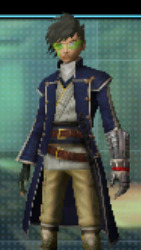
Ignore the green shades. He thinks they look cool.
At this point, Merkabah and Lucifer officially declare war and start trying to beat each other up. To stop them, you need to go through an area from the first game, interspersed with sections of Lucifer's Palace (but not Merkabah's Purgatorium, for some reason). At the center of the area, Merkabah and Lucifer are talking shit to each other, with Flynn sitting in the middle and calling them both poopyheads. At this point, you can side with either Merkabah or Lucifer to get a Law/Chaos bad ending that ends the game early, or kill both of them like the game clearly wants you to. Gaston breaks his heavenly spear and becomes a worse character by replacing it with a normal one, and some other guy does some thing that I don't care about. Once you do that, all of the evil forces of the world are totally dead, so you can go back home and celebrate! Woohoo!
At this point, I came to a realization: I was really invested in this game. Sure, the tone was very different from any other SMT game, but I didn't perceive that as a bad thing. The characters were fun (if a little simple), the plot had set up lots of interesting threads, and the gameplay and vibes were as excellent as ever. I might have even been enjoying myself more than the first game. I went into the comments section of a review to see if other people shared this opinion, and I just ended up disagreeing with most of the reasons people weren't vibing with the game, but I also came to another, much more terrifying realization:
I had stopped to check right before the plot turned into a shitshow. A magnificent one, but a shitshow nonetheless.
Surprisingly, the game doesn't actually end after you beat up Merkabah and Lucifer. At the ensuing party, Flynn reveals himself as a reincarnation of the Evil Snake from earlier and eats the souls of everyone at the party. This would probably be a much more shocking reveal if he didn't spend the entire Merkabah/Lucifer encounter making this face and the game didn't draw attention to it every single time he did.
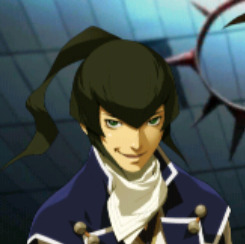
Once he reveals himself, Evil Snake jumps at Nanashi with intent to kill, but Asahi jumps in front of him to protect him, dying in the process.
I have so many questions. Didn't she know that Nanashi just comes back to life whenever he gets killed because of Dagda? I've died plenty of times throughout the game, so she had to have picked up on that by now. Is she stupid? Well, yeah, she is, but you know what I mean. Also, why can't Dagda just bring her back to life like he does with Nanashi? Is he gonna do that later in the game? Oh, God, he totally is, isn't he? And why does nobody else in the party care!?
The possible explanation for that last point is that Evil Snake just turned into a giant egg that's going to hatch and destroy the universe. Krishna shows up, says "hey bitches I didn't die", and now you gotta deal with them again. Great. At least I got Nanashi a lovely new outfit for his troubles.

The moment you get into the Cosmic Egg, Krishna turns to Toki and says one of the most stranger danger lines I've ever seen:
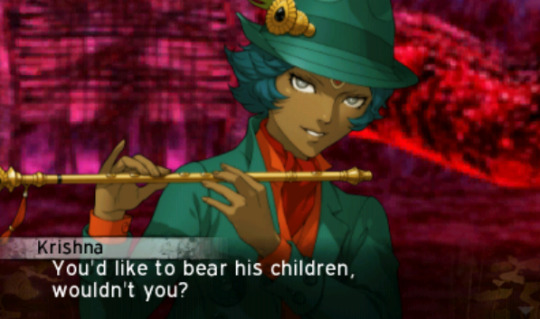
After that, he extracts the demon living inside Toki's brain (which still has her conscious inside it) and whisks her away to stuff souls into the demon to create new demons, which he will not stop describing as "giving birth". I have no idea how this got past QA and made it into the final game, especially since Toki is fourteen years old. Even more strangely, after traversing the majority of the Cosmic Egg (which looks like this the entire way through, overlay included) and defeating the demon possessing Toki, she just reverts to her personality from before the thing with the jars, implying that the way she acted for half the game was the result of that whole process altering her brain and turning her freaky. They try to insert a character arc of her trying to find inner strength or something after this, but it feels more like someone suddenly telling you about the job interview they just got out of after several hours of showing you Homestuck porn.
After another piss easy bossfight, you finally get to the decision the entire game has been building up to: destroy the Cosmic Egg with the help of your friends to preserve the current universe, or betray your friends and use Dagda's power to create a new universe where humans take back the godlike powers stolen from them by God. Since I pride myself as a comprehensive reporter, I'll be going through both of these routes, starting with...
Pacifist
On the Pacifist route, Dagda's mom shows up and tells him "fuck you, I'm gonna kill you, give me 2000 Macca" and creates another Dagda that's less of an asshole so you can kill the old one. After beating Dagda MKI up, Dagda MKII releases the souls of everyone eaten by the Evil Snake and therefore trapped within the Cosmic Egg, resulting in Asahi coming back to life completely unscathed despite her physical body clearly being eviscerated when she protected Nanashi earlier. Man.
At the end of the Cosmic Egg, you find Krishna waiting with Flynn crucified next to him. He soliloquizes a little more about saving the world, then fuses with Flynn to become Vishnu-Flynn... who I effortlessly destroyed because I accidentally set my difficulty to Conflict instead of WAR and forgot to change it back. Whoops! Also, I'm pretty sure they forgot to translate one of the dialogue options that appears when you fight him.
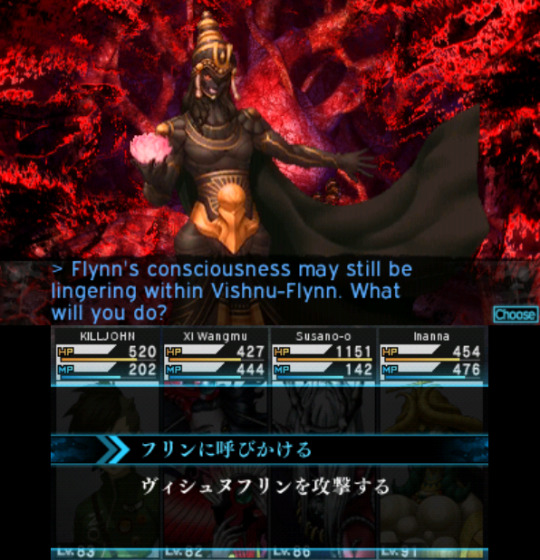
After defeating Vishnu-Flynn, Flynn separates from Krishna and deals a very anime-looking finishing blow to him. Krishna is sealed away back in that waterfall dungeon, the Cosmic Egg is deactivated and becomes a tourist attraction, and all threats to Tokyo are destroyed, so everyone from both Tokyo and Mikado can return to living peaceful lives. Also, the time dilation in Mikado is removed because the Evil Snake blasted a hole in the ceiling earlier. Sounds like a happy ending for everyone, right? WRONG! An expy of Stephen Hawking appears in the dreams of the entire party and tells them to go kill God, directing them to the universe where he lives, which is one of the most agonizing final dungeons I've ever had to sit through:

What this map doesn't show you is that every single floor here is absolutely gigantic, which, when combined with Nanashi's sluggish walk speed, results in a dungeon that may have genuinely killed me if I didn't have a guide telling me exactly where to go. Throughout the dungeon, you fight clones of Merkabah and Lucifer that God created to beat you up, and then the real Merkabah and Lucifer show up to become SATAN! He is not remotely challenging. Satan creates the door to God's house, and you finally come face to face with the big man himself... or perhaps "face to face to face to face to face to face" would be more accurate.
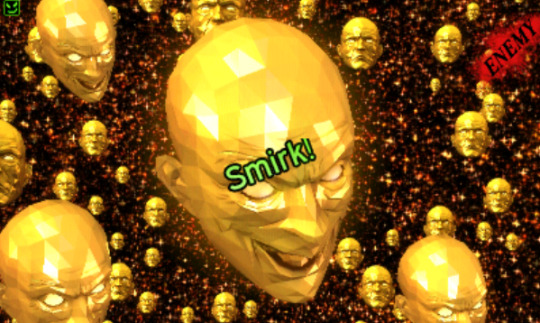
This is the funniest thing I've ever seen.
This boss is ridiculously hard, for a number of reasons:
Flynn and Isabeau split off from your party to form their own with Jonathan and Walter from the first game, who show up here just to kick God in the pants. You swap between the two parties every turn. This sounds beneficial, but Isabeau is the best partner in the game, so losing access to her for the final boss really stings.
God naturally resists all elements. To counter this, you need to have Flynn use Godslayer's Sword on him, which reduces his defense against a random ailment, and even turns it into a weakness if it hits the same element twice. There's no guaranteeing which element this skill affects, so you might end up giving him a weakness to normal attacks and absolutely destroying him... or a weakness to an element none of your demons can use.
This is a two-phase boss. The first phase is relatively inconsequential, but it does drain your patience and resources before the second phase, which is where shit gets real. He gains a skill that fully buffs all his stats and gives him a very dangerous status, a skill that fully debuffs your entire party's stats and has a chance of blocking you from using skills at all, and a full-party nuclear bomb that pierces affinities and does massive damage. Thankfully, he doesn't tend to use these skills one after the other, but it's still incredibly hard to deal with, especially since Flynn's party has a very limited set of items to work with.
The boss is levle 100, while Vishnu-Flynn was only lv87. I assume they want the player to make up the difference while going through the dungeon, but since this struck me as a massive waste of time, I fought him at around 10-15 levles below what seems to be recommended. I could have fixed this with a bit of grinding, but that's dumb and lame and I didn't wanna do it.
For all of these reasons, I was genuinely unable to do the boss on WAR difficulty and had to step down to Conflict to finish the game. It's a shame, too, because I think the concept of the boss is really cool; you need to have your entire party reject God as a concept by forming a proper understanding of him and thus denying his mysterious power, and once you do this enough, he reverts to just another regular demon that you can take down like any other. It's a pretty awesome fight from a lore standpoint, and it also fits in with absolutely nothing else from the rest of the game. After giving God the old one-two, you get a heartfelt goodbye from the gang as a slideshow of what they've been up to scrolls by, and the credits finally roll.

Ignore the guy with grey hair and the weird green ghost thing, they don't matter. This ending is kind of infamous for being incredibly saccharine and feeling more like a Persona ending than an SMT one, but at this point, I've been through enough shit that I think I've earned it. I shouldn't revel in this for too long, though, because now I have to get through...
Genocide
On the Genocide route, you side with Dagda in order to create a new universe that promotes solitude and personal strength above all else. Unfortunately, this is in direct conflict with your friends' goals, so now you have to kill all of them and harvest their souls so you have the power necessary to create a new universe. I fail to see how this makes you any different from the Divine Powers, but I digress. Hilariously, after killing all his friends, Nanashi says "Dagda" in a much more evil and fucked up way whenever he calls him to pull up the menu. Nanashi and Dagda then walk up to Krishna, tell him to stop yapping and turn into Vishnu-Flynn so they can beat him up, and... I got instantly wiped. Not only is he tougher and seemingly smarter on WAR mode, but you also obviously don't have a partner for this fight and can't reap the benefits of that. I clearly need to do some preparation to take this guy on.
Actually, that relates to something I haven't really gone into yet. Whenever I play an RPG, I have a habit of optimizing my build as much as possible over the course of the game, and SMT is no different A large part of my time with Apocalypse in particular wasn't actually spent playing it; instead, I tend to bury myself in a fusion calculator (basically a chart of every demon and every way you can fuse them together) and refuse to let myself out until I find a way to fuse the exact demon with the exact set of skills I want on it. Occasionally, I'll spend an entire day going through the calculator to find a certain combination without playing the game at all. I have mixed feelings about this habit: it's fun to figure out how to acquire the demon I want and incredibly satisfying when I find a recipe that works, and annihilating a boss with a team specifically created to exploit their weaknesses is ridiculously gratifying, but it's usually unnecessary, greatly increases the amount of time I spend on the game, and sometimes leads to me finding out about certain plot-relevant demons before I wanted to. In any case, once I found a combination of demons that was suitable to take down Vishnu-Flynn (which included Shiva, ironically enough), he went down without a sweat.
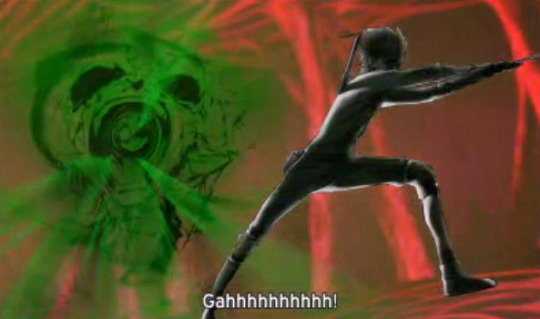
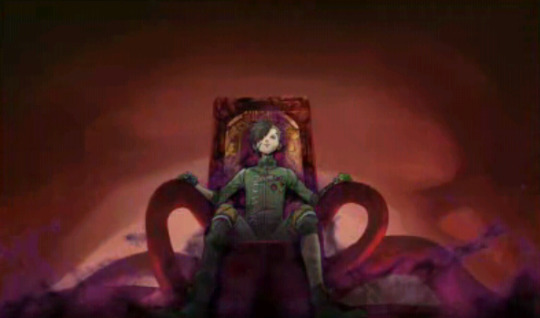
Dagda then tells Nanashi that he needs a "goddess" to properly recreate the universe. This goddess can be any of the party members you just killed (or Asahi), regardless of gender, and Dagda will bring back the one you choose as a puppet and consume the rest to fuel his new universe. He also possesses Flynn for good measure. I chose Isabeau because she has the best skills and she's a pretty woman. Oddly, Flynn essentially turns into a walking corpse who only exists to serve Nanashi, but whoever you choose as your goddess seemingly has their sanity totally intact. However, things aren't over just yet, since there's one man standing in the way of your path to godhood: the Creator God himself.
Since you actually have an impetus to kill God on this route, Stephen mostly just appears to tell you where he's at and how to do it. Once I made a pit stop to pick Krishna up from the waterfall dungeon and wiped out the Secular Press, I went back to God's Universe for a rematch against the big man. The return trip was about as interesting as the first; I tried to do some of the DLC quests, but they whooped my ass and pissed me off in equal measure, so I kept my distance and went straight to the boss with my squad:


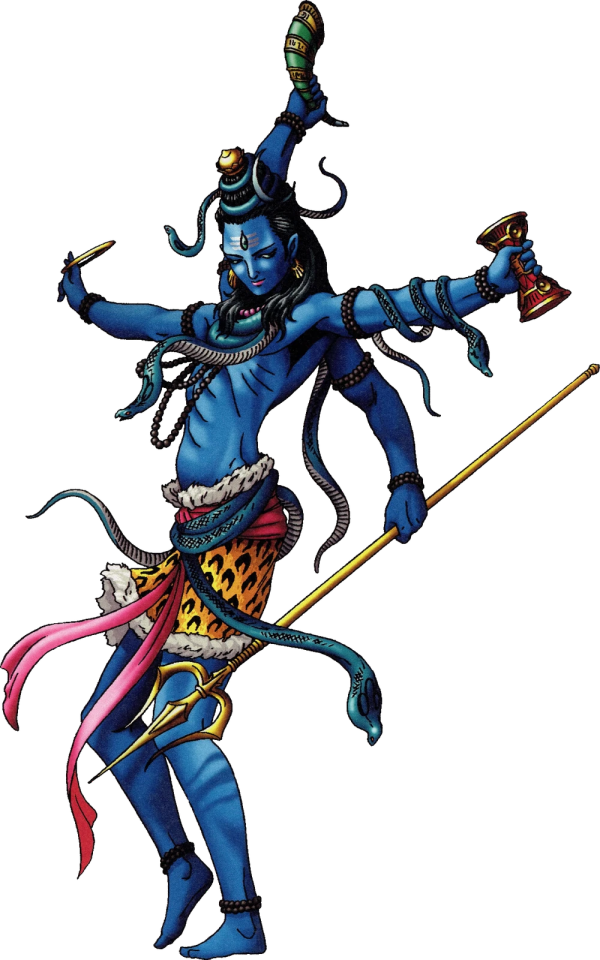
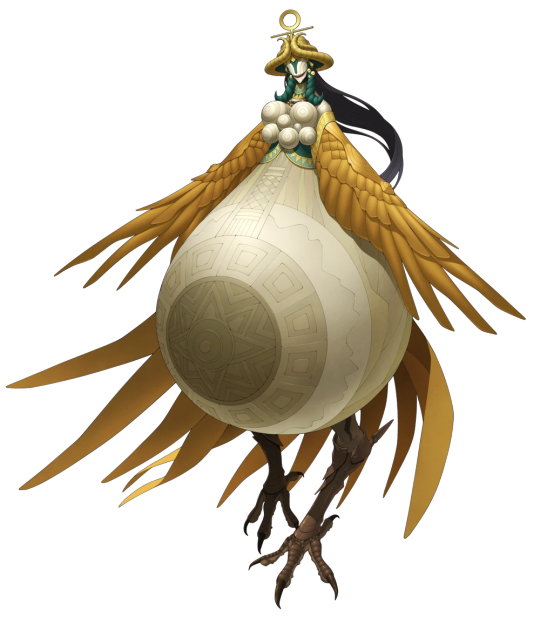
Fighting God at lv99 on WAR mode gave me much more of an appreciation for how fun the fight is. On the Genocide route, the second party consists of only Flynn and Satan, but that's hardly an issue since Satan has ridiculous health and stats and every skill you would want him to have. Instead of your friends rebuking God's pity, you have to choose the right dialogue option to disavow him and progress the fight (or at least I think; I'm not sure what getting these wrong actually does). With proper preparation, the first phase is essentially free, meaning you get to the second phase (the fun part) much more often, which is as much of an assclench as ever. He's still incredibly hard for an enemy you're expected to fight in the main game, but I thoroughly enjoy everything about the fight from both a gameplay and lore perspective, especially on this route. Once you sufficiently kick God in the pants, Nanashi takes his seat at the Throne of Creation, Stephen Hawking warns him that more messiahs will come to fight him off the throne which is clearly a teaser for SMTIV3, Dagda vanishes into the cosmos to watch over their new universe, and the credits roll.
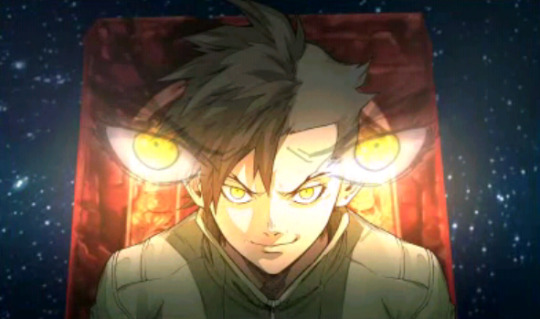
Honestly, I vastly prefer this to the Pacifist route. The act of killing your friends and possessing Flynn for your own benefit makes you feel like a bit of a dick without hamming it up for shock value too much, and actually having a reason to go to God's house and punch him in the teeth makes the ending feel a lot more natural. Also-- and this might make me sound like a psychopath-- I didn't realize how much I didn't want my friends screaming into my ear until they were all dead. That one YouTube comment I saw once was right; the best part of this game really is getting to kill your annoying ass party members. There's also a DLC where you collect the protagonists from the other games to fight Stephen Hawking, but I couldn't even get past the first phase to get to the second one where he stands up and becomes obscenely difficult.
Conclusion
Shin Megami Tensei IV Apocalypse is not a perfect game. I probably wouldn't go as far as to say it's a great game, and it's definitely worse than the original. That being said, I still had a lot of fun with it. There are a fair few genuinely novel ideas hidden behind the shaky execution, and the gameplay is absolutely phenomenal, even compared to other entries in the series. I also can't help but feel like I learned a lot about myself and how I consume games during my time with it.
I have a very particular way of playing most games. I'll usually wait until a game has been out for a while so I know what to expect and I can get it on sale, or, in the case of older games, I simply pirate it. I collect all of my preexisting knowledge on the game and go "okay, this is what everyone likes and dislikes about this thing, let's see what genuine value I can find in the good and ironic value in the bad". If I'm worried about getting something wrong during my playthrough, I find a walkthrough and follow it to a T. I report amusing happenings or interesting observations about the game in a Discord thread, and by the end, I come out with the lives of me and a couple others enriched by the experience, no matter what flaws the game may have. I am a strong believer that (almost) any game has value waiting to be found, no matter how rocky its surface may be.
SMTIVA completely broke this system. The game shattered all expectations I had for it in both good and bad ways, the walkthrough and relentless wiki-diving led to my playthrough becoming much slower and somewhat artificial, and my need to report on every single facet of the game dragged things out even more and led to me doing some things that I absolutely wouldn't bother with on a solo playthrough. My philosophy of every game having something to enjoy hasn't changed, but perhaps I should spend less of that time carefully planning out how to go through the game and what to say about it and more of it just... playing the game. As a result, this might be the only post I make in this format, or at least the only one nearly this long. I still like the idea of writing reviews here for games I finish playing, but I'll try to keep it to just a few paragraphs instead of nearly six thousand words.
In conclusion: play Shin Megami Tensei. It's based as hell. Persona, too, for that matter; regardless of how much I rag on it, that series contains my favorite games of all time. And no matter what you choose to play or how you choose to play it, remember to have as much fun as you possibly can. That's what video games were made for, after all. Before I leave, though, I have one more word of wisdom for all of you:
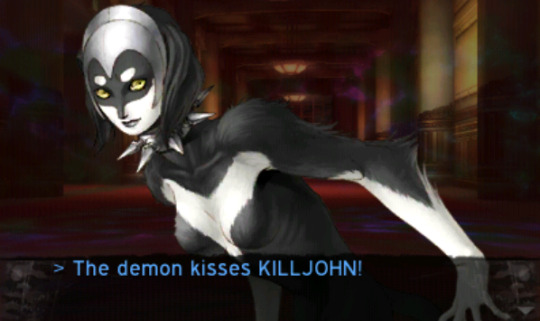
Nice
#it's true!#smt#shin megami tensei#smtiv#smtiva#smt4a i guess some people spell it like that#i wish jack frost was my dad
3 notes
·
View notes